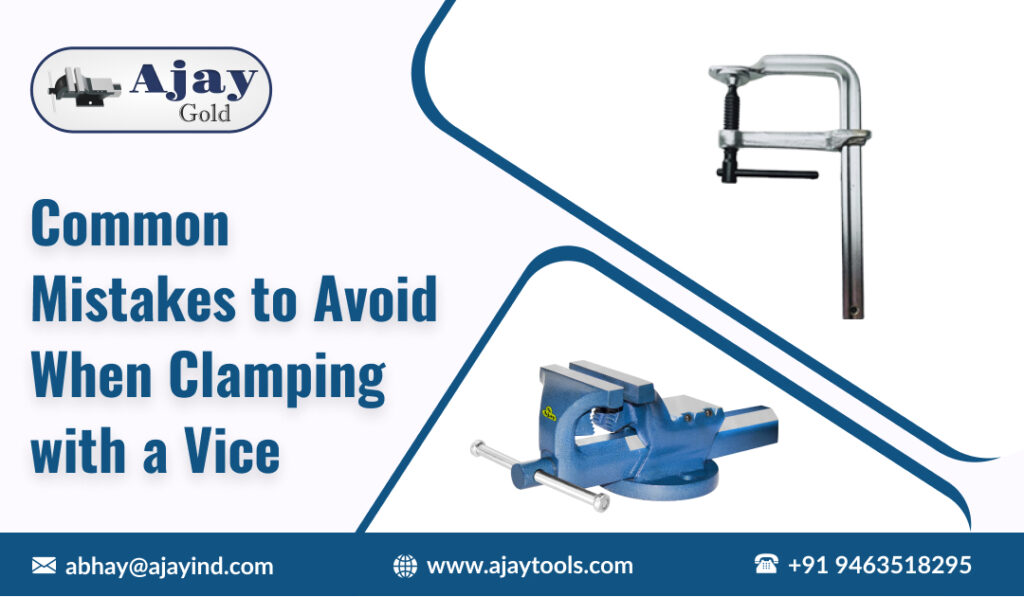The vice is an essential tool used by professionals and DIY enthusiasts to perform numerous tasks. You can commonly find a bench vice in mechanical, woodworking, or metalworking shops. The workpiece can be securely held between the jaws of a vice for precision shaping, cutting, drilling, and more. However, its potential relies on its capability to clamp objects of different sizes and shapes. Many individuals make simple yet costly mistakes when using a forged bench vice to clamp irregularly shaped objects. In this blog post, we’ll explore common mistakes made by individuals when clamping with a vice.
What should be avoided when clamping with a vise?
It’s essential to use a vice in the right way to avoid damaging the vice or the material. By learning from these mistakes, your vise can offer a longer service life. When using any type of vice, it’s important to avoid making the following mistakes:
- Widening the jaws beyond their limit or capacity
Avoid widening the jaws more than they are designed for, as this can compromise the grip and stability of a vice.
- Over-tightening the vice
Don’t attempt to over-tighten the vice, as this can damage both the vice and the materials which is held between the jaws.
- Excessive clamping pressure
Be careful when applying excessive pressure, as this can result in damage to the material or object that is being clamped with a vice.
- Self-repair
Don’t attempt to repair the bench vice by brazing or welding, as this can directly affect the quality of the vice.
- Using it as an anvil
Many individuals often use a bench vice as an anvil. Don’t use it as an anvil because it can damage the vice.
- Inadequate workpiece position
When placing the workpiece, it’s essential to securely position it in the vise so that the jaws of the vice are aligned with the object.
What are the benefits of using a bench vice?
A bench vice is a critical tool for DIYers, providing numerous advantages that greatly improve the efficiency and precision of your projects. These advantages include:
- Enhanced Stability and Precision
The main benefit is its capacity to securely hold materials, ensuring optimal stability while working. This reliable grip guarantees accurate drilling, cuts, and shaping, allowing you to achieve exceptional results. When buying a work bench with vice, ensure mounting a vice securely to increase productivity and performing tasks easily.
- Time and Effort Efficiency
By firmly clamping materials, bench vices make complicated tasks easier, saving both time and energy. Intricate activities like carving, sanding, or detailed assembly are simplified, allowing you to focus on the creative part of your project.
- Longevity and Value
Investing in a high-quality bench vise offers a durable tool that will last for years. Well-constructed vices are made from strong materials, ensuring they withstand regular use and maintain their precision, providing lasting value for your DIY projects.
Identifyinmg these benefits shows how crucial a bench vice is for DIY work. However, to fully benefit from its features, it is essential to understand the safety guidelines associated with using this tool.
How to use a bench vise safely?
When using a vice, you need to follow various safety precautions to ensure you work carefully:
- When using a vise, ensure wearing appropriate Personal Protective Equipment. Wear safety glasses to protect your eyes and sturdy gloves for hand protection. Wearing protective gear ensures you can handle your project securely using a bench vise.
- It is essential to use a vise on a stable surface to prevent accidents and ensure accuracy in work. Additionally, ensure the worktable and a vise are levelled.
- The safe operation of a bench vice relies on routine maintenance and careful inspection. Regularly check each component of the vice:
- Inspect the jaws for signs of wear.
- Verify the handle and screw mechanism are functioning properly.
- Make sure the base is securely fastened.
- Using a checklist can help ensure no detail is missed during your inspection.
Conclusion
A bench vise is an essential tool used in several industries. If you use a bench vise, make sure to avoid making the mistakes mentioned in this blog. If you are looking for high-quality and different types of bench vises, you can contact Ajay Tools.


